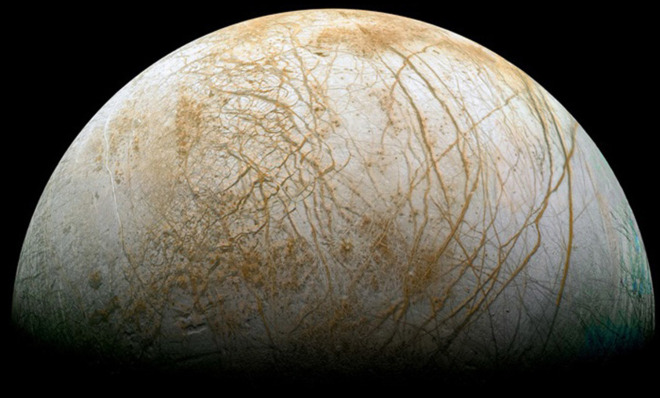Is there life on Jupiter’s moon?
Now we can find out…

The hunt for alien life just made a pretty big breakthrough.
Unfortunately — or perhaps fortunately — we're not anticipating flying saucers on the White House lawn anytime soon. Instead, scientists discovered a (relatively) easily-accessible source of hydrogen and oxygen — which together make water, one of the most basic ingredients for life — on one of Jupiter's moons.
There is already lots and lots of evidence for the existence of both liquid and frozen water in other parts of our solar system. Frozen water is abundant in asteroids. In 2009, huge amounts of frozen water were found on Earth’s moon. Some scientists suggest that Mars’ surface has been shaped by the flow of liquid water, and NASA’s Curiosity rover found frozen water in soil samples on Mars just this year. And back in 2000, the Galileo probe found evidence of water on Jupiter’s moons Ganymede and Europa — and scientists believe that liquid oceans of water are trapped beneath the the moons' frozen surfaces.
The Week
Escape your echo chamber. Get the facts behind the news, plus analysis from multiple perspectives.

Sign up for The Week's Free Newsletters
From our morning news briefing to a weekly Good News Newsletter, get the best of The Week delivered directly to your inbox.
From our morning news briefing to a weekly Good News Newsletter, get the best of The Week delivered directly to your inbox.
Many have long wanted to send a probe to these moons to drill down beneath the surface and search for life. After all, another key component of life — organic compounds — have been spotted on the surface of Europa. And the oceans beneath the ice are likely to harbor thermal vents and volcanoes similar to Earth's, around which the first single-cell life on our planet may have evolved from the heated soup of water and organic compounds. But the only way to tell is by testing the hypothesis. And unfortunately, sending a complex drill probe to the surface is seen by many as too costly and risky, and the project has gone unfunded for years.
Yesterday, however, NASA announced a major breakthrough: It had used images from the Hubble Space Telescope to identify bursts of hydrogen and oxygen — the two components of water — above the surface of Europa. These bursts of hydrogen and oxygen were observed for seven hours at a time as Europa reached the furthest point of its elliptical orbit away from Jupiter.
This suggests that the geysers of water may be triggered by the huge gravitational forces that Jupiter — a planet with a mass 317 times greater than the Earth — exerts on the moon. These geysers have been estimated as being 200km high, many times higher than the Earth’s highest mountains.

Here's the key part for exploration efforts: The fact that Europa is ejecting water into the sky means no drilling would be necessary to analyze it for signs of life. No drilling means no worries over landing a probe on the surface of an inhospitable planet (something which has gone wrong numerous times in the past). The probe would just have to fly through the atmosphere and collect samples.
A free daily email with the biggest news stories of the day – and the best features from TheWeek.com
Some Congressmen are already calling for a new mission to Europa to see what we can find. Rep. John Culberson (R-Texas) argues:
When we first find life in our solar system, it will be living in the vast oceans of Europa. This exciting revelation further solidifies the need for the Flagship Class mission to Europa that the scientific community has been clamoring for, the Planetary Science Decadal Survey has endorsed, and we in Congress have mandated by law. I look forward to working with my colleagues in Congress to ensure that a Europa mission has the full support of the federal government. [Planetary.org]
If the mission gets the go-ahead, there is a chance that we could be the generation to discover that we aren’t alone in the universe…
John Aziz is the economics and business correspondent at TheWeek.com. He is also an associate editor at Pieria.co.uk. Previously his work has appeared on Business Insider, Zero Hedge, and Noahpinion.
-
 ‘Care fractures after birth’
‘Care fractures after birth’instant opinion Opinion, comment and editorials of the day
-
 Shots fired in the US-EU war over digital censorship
Shots fired in the US-EU war over digital censorshipIN THE SPOTLIGHT The Trump administration risks opening a dangerous new front in the battle of real-world consequences for online action
-
 What will the US economy look like in 2026?
What will the US economy look like in 2026?Today’s Big Question Wall Street is bullish, but uncertain